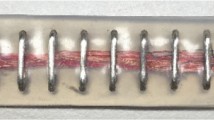Abstract
Simulation models are necessary for testing the performance of newly developed approaches before they can be applied to interpreting experimental data, especially when biomedical signals such as surface electromyogram (SEMG) signals are involved. A new and easily implementable surface EMG simulation model was developed in this study to simulate multi-channel SEMG signals. A single fiber action potential (SFAP) is represented by the sum of three Gaussian functions. SFAP waveforms can be modified by adjusting the amplitude and bandwidth of the Gaussian functions. SEMG signals were successfully simulated at different detected locations. Effects of the fiber depth, electrode position and conduction velocity of SFAP on motor unit action potential (MUAP) were illustrated. Results demonstrate that the easily implementable SEMG simulation approach developed in this study can be used to effectively simulate SEMG signals.









Similar content being viewed by others
References
Stegeman DF, Blok JH, Hermens HJ, Roeleveld K. Surface EMG models: properties and applications. J Electromyogr Kinesiol. 2000;10:313–26.
Nandedkar SD, Stalberg EV, Sanders DB. Simulation techniques in electromyography. IEEE Trans Biomed Eng. 1985;32:775.
Roeleveld K, Blok JH, Stegeman DF, van Oosterom A. Volume conduction models for surface EMG; confrontation with measurements. J Electromyogr Kinesiol. 1997;7:221–32.
Farina D, Rainoldi A. Compensation of the effect of sub-cutaneous tissue layers on surface EMG: a simulation study. Med Eng Phys. 1999;21:487–97.
Merletti R, Lo Conte L, Avignone E, Guglielminotti P. Modeling of surface myoelectric signals—Part I: model implementation. IEEE Trans Biomed Eng. 1999;46:810–20.
Merletti R, Roy SH, Kupa E, Roatta S, Granata A. Modeling of surface myoelectric signals—Part II: model-based signal interpretation. IEEE Trans Biomed Eng. 1999;46:821–9.
Farina D, Merletti R. A novel approach for precise simulation of the EMG signal detected by surface electrodes. IEEE Trans Biomed Eng. 2001;48:637–46.
Blok JH, Stegeman DF, van Oosterom A. Three-layer volume conductor model and software package for applications in surface electromyography. Ann Biomed Eng. 2002;30:566–77.
Mesin L, Farina D. An analytical model for surface EMG generation in volume conductors with smooth conductivity variations. IEEE Trans Biomed Eng. 2006;53:773–9.
Mesin L. Volume conductor models in surface electromyography: applications to signal interpretation and algorithm test. Comput Biol Med. 2013;43:953–61.
Boyd DC, Lawrence PD, Bratty PJ. On modeling the single motor unit action potential. IEEE Trans Biomed Eng. 1978;25:236–43.
Nandedkar SD, Stalberg E. Simulation of single muscle fibre action potentials. Med Biol Eng Comput. 1983;21:158–65.
Rau G, Disselhorst-Klug C, Silny J. Noninvasive approach to motor unit characterization: muscle structure, membrane dynamics and neuronal control. J Biomech. 1997;30:441–6.
Holobar A, Minetto MA, Botter A, Negro F, Farina D. Experimental analysis of accuracy in the identification of motor unit spike trains from high-density surface EMG. IEEE Trans Neural Syst Rehabil Eng. 2010;18:221–9.
Rau G, Disselhorst-Klug C. Principles of high-spatial-resolution surface EMG (HSR-EMG): single motor unit detection and application in the diagnosis of neuromuscular disorders. J Electromyogr Kinesiol. 1997;7:233–9.
Schulte E, Farina D, Rau G, Merletti R, Disselhorst-Klug C. Single motor unit analysis from spatially filtered surface electromyogram signals. Part 2: conduction velocity estimation. Med Biol Eng Comput. 2003;41:338–45.
Chen M, Zhou P. A novel framework based on FastICA for high density surface EMG decomposition. IEEE Trans Neural Syst Rehabil Eng. 2016;24:117–27.
De Luca CJ, Adam A, Wotiz R, Gilmore LD, Nawab SH. Decomposition of surface EMG signals. J Neurophysiol. 2006;96:1646–57.
McGill KC. Surface electromyogram signal modelling. Med Biol Eng Comput. 2004;42:446–54.
Holobar A, Zazula D. Multichannel blind source separation using convolution kernel compensation. IEEE Trans Signal Process. 2007;55:4487–96.
Clark J, Plonsey R. A mathematical evaluation of the core conductor model. Biophys J. 1966;6:95–112.
Merletti R, Parker PA. Electromyography: physiology, engineering, and non-invasive applications. London: Wiley; 2004.
Stashuk D. EMG signal decomposition: how can it be accomplished and used? J Electromyogr Kines. 2001;11:151–73.
Zazula D, Plévin E. An approach to decomposition of muscle and nerve signals. In: International conference on signal, speech, and image processing ICOSSIP ’02, Skiathos, Greece; 2002.
Ning Y, Zhu X, Zhu S, Zhang Y. Surface EMG decomposition based on K-means clustering and convolution kernel compensation. IEEE J Biomed Health Inform. 2015;19:471–7.
Keenan KG, Farina D, Merletti R, Enoka RM. Amplitude cancellation reduces the size of motor unit potentials averaged from the surface EMG. J Appl Physiol. 2006;100:1928–37.
Farina D, Fortunato E, Merletti R. Noninvasive estimation of motor unit conduction velocity distribution using linear electrode arrays. IEEE Trans Biomed Eng. 2000;47:380–8.
Acknowledgements
This work was supported in part by National Natural Science Foundation of China 51677171, Zhejiang Provincial Natural Science Foundation of China LY17C100001, Department of Education of Zhejiang Province Y201533132, Guangdong Provincial Work Injury Rehabilitation Center, and the University of Houston.
Author information
Authors and Affiliations
Corresponding author
Ethics declarations
Conflict of interest
Y. Ning declares that he has no conflict of interest in relation to the work in this article. Y. Zhang declares that he has no conflict of interest in relation to the work in this article.
Rights and permissions
About this article
Cite this article
Ning, Y., Zhang, Y. A new approach for multi-channel surface EMG signal simulation. Biomed. Eng. Lett. 7, 45–53 (2017). https://doi.org/10.1007/s13534-017-0009-4
Received:
Revised:
Accepted:
Published:
Issue Date:
DOI: https://doi.org/10.1007/s13534-017-0009-4




